Smarties Best Children's Book of the Year Award 1990
Boston Globe-Horn Book Honor Award 1990
Japanese Picture Book Award 1991
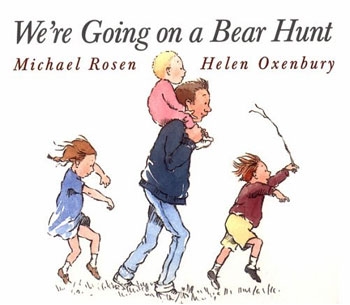





Summary
A father and his young children go out in search of a bear. On the way, they travel through the long and wavy grass, across a river, wade through thick and oozy mud, walk through a big and dark forest, meet a swirling and whirling snowstorm, and experience the cave which has a big surprise in it – A BEAR! Despite the strong curiosity, they have another journey which is all the way back home with fear.
Analysis
Characters
1) Types of Characters:
Protagonist (hero): A father and his young children
Antagonist (villain): The bear
Foil Character:
the grass, the river, the mud, the forest, the snowstorm, and the cave
2) The way characters are portrayed:
Flat Characters (stock, static characters or stereotypes)
Setting
1) Type of setting: Backdrop Setting
Narrative Point of View
Internal Narrator
(the 1st person point of view; the narrator uses "we" to refer to themselves)
Plot
Type of plot structure:
A Progressive or Dramatic Plot: First establishes the setting (A father and his children are going on a bear hunt.) and conflict (They go through grass, a river, mud, a forest, and a snowstorm.), then follows the rising action (They finally get to the cave) through to a climax (They walk through the cave and they find the bear), and concludes with a denouement (Everyone gets scared and go back through the cave, the snowstorm, the forest, the mud, the river, the grass, and finally back to the house.).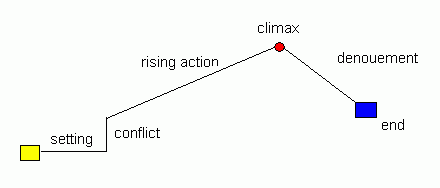
Conflict
1) Common types of conflicts:
The Protagonist against Self
The father and the children are afraid of the bear but they still are willing to have a bear hunt.
The Protagonist against Nature
The grass, river, mud, forest, snowstorm, and cave make the journey of the bear hunt more difficult.
Theme
The thematic issue in “We’re going on a bear hunt” is the Nature. People should respect and care for their natural surroundings. Plus, indeed, learn about the natural world and how humans fit into ecology.
Tone
Diction
The repetitive words are filled up in the whole story with humorous tone in order to make younger readers get the picture easier and follow the plots with their high interests. It is not difficult to find out that there is some onomatopoeia placed in the story. By the effect of onomatopoeia words such as Swishy Swashy, Splash Splosh, Squelch Squerch, Stumble Trip, Hoooo Woooo and Tiptoe, not only are the younger readers able to imagine what is happening, but adult readers would enjoy having the moment saying those words repeatedly while they are recalling their old experience of going through the natural scenes.
Images
The author, Michael Rosen, successfully utilizes one of the senses - the sound of what we hear to create a vivid reading environment. A two-page description of current events, with repeated sentences, and another two-page of onomatopoeia only are combined in each experience which brings out different sounds of nature to stimulate the readers' imagination. Also, the onomatopoeia is placed in the story so that the readers could recite or read the whole story like a chant. The evidence is shown in one of the movie clips from youtube - kindy students have no trouble chanting "We're going on a bear hunt."
Click to see the video:
http://tw.youtube.com/watch?v=I70UdCbYcPE&feature=related
Details
When the explanations and descriptions are needed, some authors would use longer sentences to help clarify their ideas, however, Michael Rosen uses simple understanding words and shorter sentences to achieve this goal. He excludes the unnecessary words to polish the conception of nature for readers. In the mean time, some adjectives used for certain nouns effectively describe the beauty of the scenes. The examples are as follows.
Long, wavy grass
Deep, cold river
Thick, oozy mud
Big, dark forest
Swirling, whirling snowstorm
Narrow, gloomy cave
Language
Obviously, the exclamation marks are placed by the time the whole family meet a new challenge in order to emphasize their feelings. For instance,"A snowstorm!" "Oh, no!" "Two big furry ears!" Besides that, father uses imperitives while he tells his children what to do next because they do not have sufficient time to think about the next move; furthermore, there is no chance of saying no from children due to the emergency. To illustrate this, here are some examples that are very concrete.
Quick! Back through the cave! Tiptoe! Tiptoe! Tiptoe!
Shut the door. Back upstrairs. Into the bedroom. 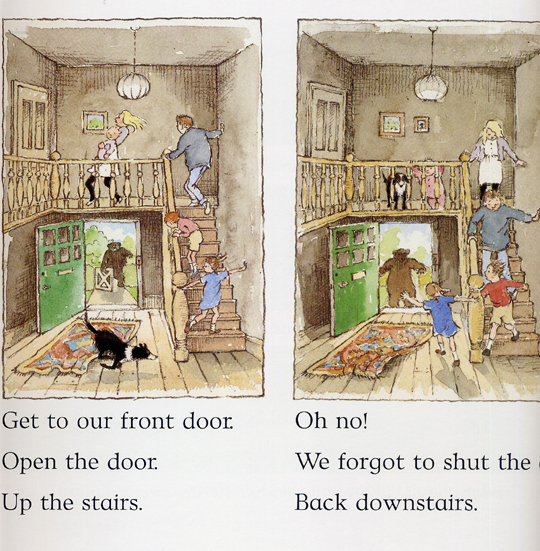
Sentence Structure
Through parallel sytax, the author creates interconnected emotions, feelings and ideas. Morever, short sentences are usually more punchy and intense for the characters in this story to express their reaction of the sudden encounter.
Illustration
"We're going on a bear hunt" is illustrated by Helen Oxenbury, a famous illustrator who won the distinguished English award for picture-book artists, the Kate Greenaway Medal. Before the last few pages of seeing the bear, black-and-white and colorful pictures are alternated in large two-page scenes which give the readers a vigorous imagination and points out how careful they go through this journey. Conversely, as soon as they find the bear in the cave, the pictures, six rectangles in two pages, become smaller to reveal the father and the children's fear and anxiety within a short time. Once they get home, the pictures become a bit bigger since their mood gets more light-hearted than the moment they see the bear and their movement finally gets slow down. Later, a two-page picture displays their mood being totally at ease because the door is locked and the bear is left with loneliness and sadness. 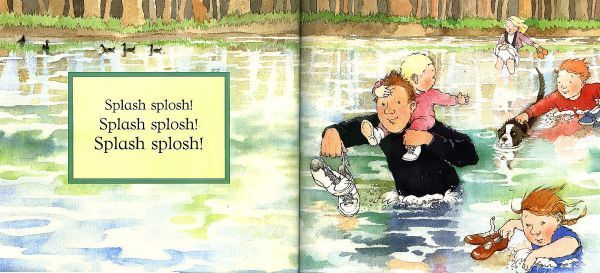

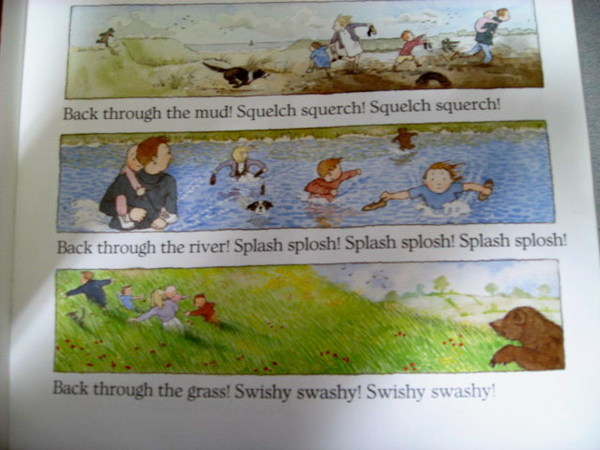
Reflection
First, The beautiful illustration, interesting repetitive sentences, exciting plots and a big surprise at the end truly raise my interest to this book, more than one million copies sold. Due to the chantable text, the interaction between the readers and the book wins a great reputation all over the world. I, personally, also enjoy watching the video clip from youtube (see above) since the kid was able to combine the movements and the chant. What an adorable kid dancing with great background music! In the near future, I definitely will share this storybook and the chant with my students to bring them some fun and absorb new vocabulary by mimicking the sounds and performing the actions.
Second, this story is worth to read many times for adults and children. The onomatopoeia words such as Swishy Swashy, Splash Splosh, Squelch Squerch, Stumble Trip, Hoooo Woooo and Tiptoe prompts me to read aloud and practice reading it again and again because it is just like a tongue twister for me as an adult to practice my pronunciation. The story becomes more intense as well while I read it with a higher speed.
After recommending "Voices in the Park," this is the second book that I would like to give it a big thumb for parents and teachers who are dedicating themselves winning kids' hearts and providing kids an educational experience through story-telling. I guarantee that the kids will never get bored of reading it. For this reason, the kids would probably read it back to you for countless times.
